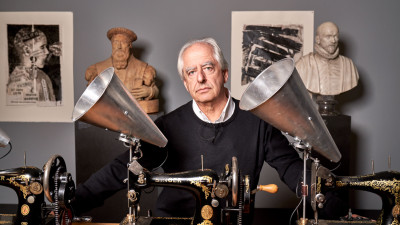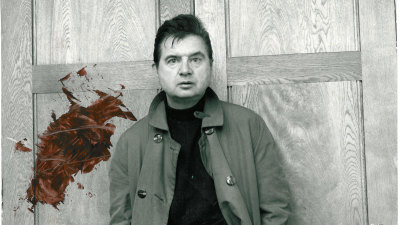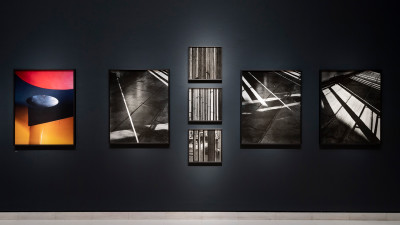Ai Weiwei at the RA: Sharing our vision for the show
Ai Weiwei at the RA: Sharing our vision for the show
Behind the scenes
By Adrian Locke
Published 7 July 2015
Our collaboration with Ai Weiwei has extended to producing the exhibition’s poster image, catalogue and multimedia guide, explains curator Adrian Locke.
-
Part five in a series of blogs telling the story of how our forthcoming Ai Weiwei exhibition – the latest in our sequence of major single artist shows – is being put together across 10 months, by teams across three continents.
Agreeing the content is a fundamental stage of any exhibition’s planning, but it is only one element – albeit a crucial one – in the whole process. Parallel activities take place on many different fronts across the organisation, including preparing the catalogue, producing interpretative material and creating a poster to market the exhibition.
The RA, through its publishing wing, produces a catalogue for every show. These are lasting records of the idea behind and content of each exhibition. Essays help to give context to the artist and the selection of his works. As with many contemporary artists we wanted to capture his words at this specific moment in his career; artists often find it easier to articulate what they are doing and why through conversation as opposed to the formality of putting those words down on paper. To this end Tim Marlow, our Artistic Director, met Ai Weiwei at his studio in Caochangdi to record an interview with him. The interview was filmed so that we could use selected excerpts of the footage on our website (you can watch the first clip in this series below), and transcribed for the catalogue.
-
Ai Weiwei and Tim Marlow in conversation
In this video, recorded at his studio in Beijing, Ai Weiwei talks to the RA’s Artistic Director Tim Marlow about his artistic influences and the role of politics in his work.
-
Ai’s art is multi-layered and he is very keen, as indeed are we, that visitors to the exhibition are given keys to help unlock some of the mysteries of his work. Given that he is so articulate it made perfect sense to use his words to help the visitor navigate the exhibition. I returned to Beijing in April and interviewed Ai in his hotel room, where he has been staying in order to focus on writing a book about his father, the celebrated poet Ai Qing. I had taken a professional voice recorder with me but Ai took one look at it and suggested we use my iPhone instead, a device he uses to record all his meetings. He spoke without stopping for an hour, describing each work in the exhibition. These words, delivered with clarity, honesty and sometimes humour, will form the basis of the universal multimedia guide produced by Antenna International. This means it will be included in the ticket price for every visitor, only the second time this has been done at the RA (Aztecs in 2002 being the first), with multiple layers of additional material not included in the exhibition itself.
-

A meeting to discuss the contents of the exhibition's multimedia guide
Photo: © Royal Academy of Arts, London
-
The poster is another key element in the planning of any exhibition. We very much wanted the poster – an image that will be widely displayed on the Tube, across London and further afield – to be a collaboration between the RA and the artist, an approach that we used successfully with Anish Kapoor, David Hockney and Anselm Kiefer. In this case, Ai Weiwei – who is still without his passport – was unable to meet with us here in London, so we found another solution. We have worked with Harry Pearce, of the international design consultancy Pentagram, for many years. We agreed that he would spend time with Ai in Beijing so they could work on the poster together. Harry describes this experience below, in an extract from the Pentagram blog:
-
-

Shooting Ai Weiwei
Designer Harry Pearce on creating the exhibition’s poster image
We agreed to meet at 11am on my second day in Beijing. I had no idea of exactly what we would be doing, except that Weiwei asked I bring my cameras. I jumped in his car with him… an hour or so later we arrived at his enormous, ex-tractor factory of a studio.
As I walked into the space it took my breath away. It was like an industrial cathedral, bathed in a sawdust light. Everywhere was work in progress, and of such a scale. Giant ceramics, candelabras of glass and bicycles reaching way up into the arching ceiling, dozens of huge re-constructed trees, and so much more. I understand now how Howard Carter felt on the first moment of opening and peering into Tutankhamun’s tomb and exclaiming – “I see wonderful things”. Ai Weiwei saw the look in my eyes, as I spoke about the quality of the light, and he smiled and just said ‘I knew this is what we had to do’.
Eventually Ai Weiwei and I began to find our way amongst the pieces of sculpture and I started to photograph him. We moved with the light that streamed in through hazy windows. As he was moving to the back of the building, toward the huge doors into the courtyard beyond, an extraordinary pattern of sunlight came through a window high up in the vaulted ceiling. It fell across the back wall and ran along the floor right up to my feet. Weiwei simply stepped into this light and I began shooting and walking backwards till I caught him and the workings of his studio around him.
Out of nowhere came something so personal. I felt so honoured to have had this time with Ai Weiwei.
-
-
Work continues on the exhibition, but achieving these three major milestones marks a significant moment in the evolution of Ai Weiwei at the RA, which is now only weeks away from opening in September.
Ai Weiwei is in the Main Galleries from 19 September — 13 December 2015.





